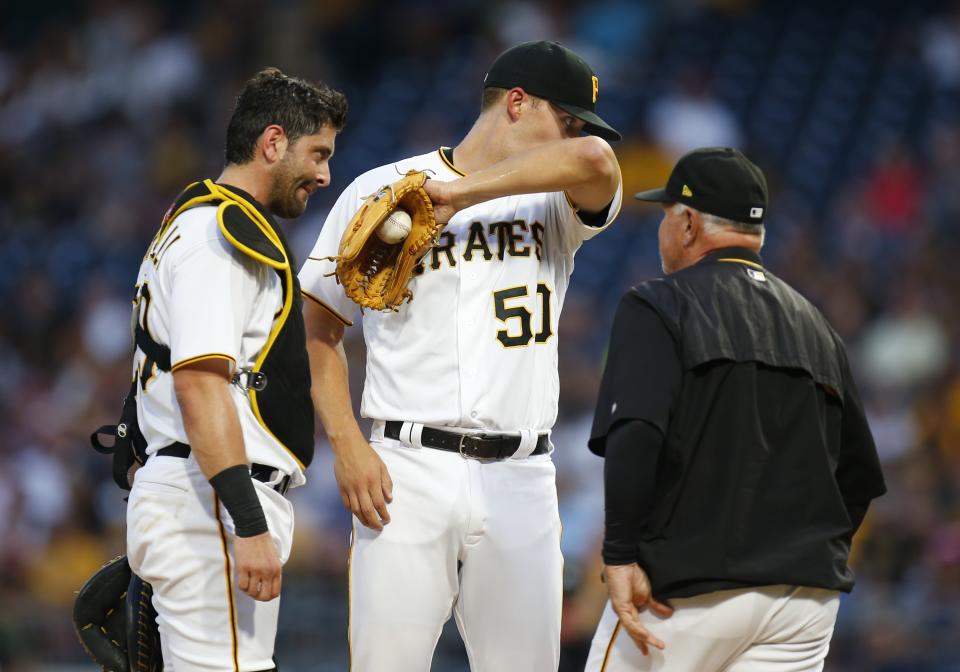MLB's new pace-of-play rules: No pitch clock, but mound visits are limited
A pitch clock won’t be coming to Major League Baseball. Not yet at least.
The league announced Monday this year’s new pace-of-play rules, and they’re highlighted by compromise. A long-talked-about pitch clock, which the MLB Players Association didn’t want, is off the table for now. Instead, MLB is putting a limit on mound visits — six per nine-inning game, whether they’re from coaches in the dugout or players on the field.
[Batter up: Join a Yahoo Fantasy Baseball league for free today]
In the weeks leading up to the decision, MLB commissioner Rob Manfred has said he could impose whatever pace-of-play changes he wanted without the approval of the players’ union, if the two sides didn’t find a middle ground. It didn’t come to that, as Manfred noted in the league’s announcement:
“I am pleased that we were able to reach an understanding with the Players Association to take concrete steps to address pace of play with the cooperation of players. My strong preference is to continue to have ongoing dialogue with players on this topic to find mutually acceptable solutions.”
Last year, the average time for a nine-inning game in Major League Baseball was 3:05, up from 3:00 in 2016 and up almost 10 minutes from 2:56 in 2015. And those numbers are much higher than 20 and 30 years ago. The average nine-inning game was 2:52 in 1997 and 2:47 in 1987.
Now, the 2018 season will essentially give the players a chance to speed up the game on their own terms before the league mandates a pitch clock. As MLB’s announcement said: “The Commissioner has decided to defer the implementation of a pitch timer and a between-batter timer in 2018 in order to provide players with an opportunity to speed up the game without the use of those timers.”
As much as MLB is pushing this as a compromise, union chief Tony Clark made it clear in a statement that his organization is still worried about the “fabric of the game,” which could mean that not everyone was on board with this compromise or the union is already lobbying against the pitch clock for next year.
Statement of #MLBPA Executive Director Tony Clark regarding pace-of-game… pic.twitter.com/Sx2SCDypKG
— #MLBPA (@MLB_PLAYERS) February 19, 2018
Capping the number of mound visits isn’t unique. It’s something that’s been used in the Atlantic League, for instance. Here are the specifics about how it will work in MLB:
I. Mound Visits
(1) Number.
a. 2018 Championship Season. Mound visits without a pitching change shall be limited to six (6) per team, per nine innings. For any extra-innings played, each Club shall be entitled to one additional non-pitching change mound visit per inning.
b. OBR 5.10(l). Official Baseball Rule 5.10(l), which governs mound visits by a manager or coach, remains in effect (i.e., a pitcher must be removed on the second visit by a manager/coach in an inning).
(2) Definition of Mound Visit. A manager or coach trip to the mound to meet with the pitcher shall constitute a visit. A player leaving his position to confer with the pitcher, including a pitcher leaving the mound to confer with another player, shall also constitute a mound visit, regardless of where the visit occurs or the length of the visit, except that the following shall not constitute mound visits:
a. Discussions between pitchers and position player(s) that (i) occur between batters in the normal course of play and do not require either the position player(s) or the pitcher to relocate;
b. Visits by position players to the mound to clean spikes in rainy conditions;
c. Visits to the mound due to an injury or potential injury of the pitcher; and
d. Visits to the mound after the announcement of an offensive substitution.
(3) Cross-Up in Signs. In the event a team has exhausted its allotment of mound visits in a game (or extra inning) and the home plate umpire determines that the catcher and pitcher did not have a shared understanding of the location or type of pitch that had been signaled by the catcher (otherwise referred to as a “cross-up”), the home plate umpire may, upon request of the catcher, allow the catcher to make a brief mound visit. Any mound visit resulting from a cross-up prior to a team exhausting its allotted number of visits shall count against a team’s total number of allotted mound visits.
Last season, the players’ union rejected a pace-of-play proposal that would have limited mound visits from catchers to once per inning. This new rule allows even less wiggle room. And what happens when a team tries to go past its six visits? Well, it’s not spelled out in the rule, but Joel Sherman of the New York Post reports the following:
Been told that there is no penalty for 7th visit to mound, that umps will just disallow it, which I see causing problems both hysterical and confrontational.
— Joel Sherman (@Joelsherman1) February 19, 2018
Other notable changes in the 2018 pace-of-play rules: The league is trying to speed up replay reviews by giving review rooms direct access to slow-motion camera angles and, as previously reported, the league will begin to monitor dugout phones to make sure teams aren’t using replay equipment to steal signs.

More MLB coverage from Yahoo Sports:
– – – – – –
Mike Oz is a writer at Yahoo Sports. Contact him at mikeozstew@yahoo.com or follow him on Twitter! Follow @MikeOz

